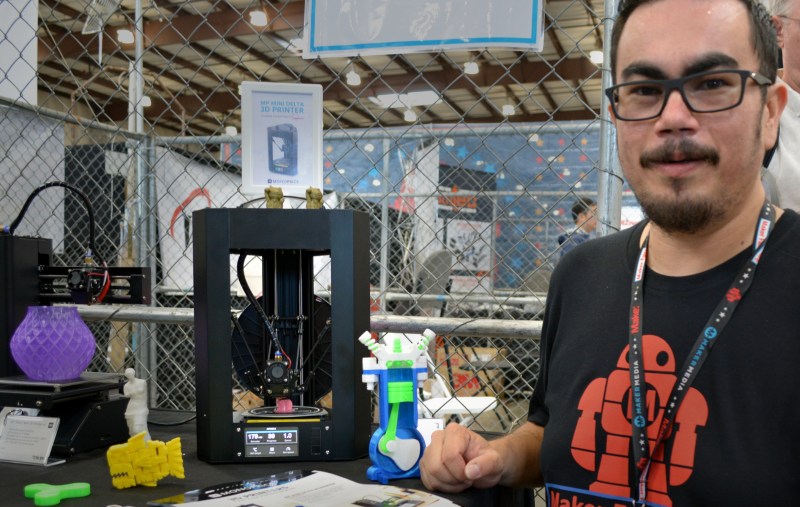When I was at Bay Area Maker Faire a few weekends ago I stopped by the Monoprice booth to chat with [Chris Apland], their head of 3D Printing. Earlier in the week, the company had just announced preorders for their new $169 delta-style 3D printer called the MP Mini Delta.
[Brian Benchoff] covered that launch and I don’t have a lot of details about the machine itself to add. I saw it in action, printing tiny waving cat models. The stock printer can use ABS or PLA and has a build volume of 110mm in diameter and 120mm tall and these preorder units (being sold through Indegogo) will begin shipping in August.
What was of interest is to hear the shipping estimates the Monoprice team is throwing around. Chris told me that their conservative estimate is that 20,000 of these printers will ship through this preorder, but he is optimistic that by the end of the fourth quarter they’ll be closer to 100,000 units. That is incredible.
Part of the promise here is the out of the box functionality; [Chris] mentioned having a printed cat in your hands within 5 minutes. If it can actually do that without the need for setup and calibration that’s impressive. But I know that even seasoned printing veterans are interested in seeing how fast they can run this tiny delta and still turn out quality prints.
You’ll find the video interview after the break.




















print speed doesnt look any better than my printrbot play. quality is down abit too. and the area is smaller (i have the y axis upgrade though).
I have the play too. Great printer! But it cost me a lot more than $169, it’s more than double that and that’s without their expensive EU shipping.
If I could get this one on the side I would… But I don’t think they do EU at all :(
the other side of it is i bought my play almost 2 years ago. at the time i was shopping around in the $300-600 usd range, and there weren’t many available at the time. the only other printers around at the time at that price point were either using chipped filament, or were just bad machines.
of course had a sub $200 machine been available at that time i might have opted for it instead. the play was $400 ish, and i bought it with the y axis upgrade and a bunch of filament so it was about $500. buy a cheap printer and then print a better printer kind of thing.
the sound on that video is pretty bad…
Is he recording the audio on a greeting card or something?
Hi Guys, I wanted to clarify and say the cat’s printing are our default calibration print ( they run at the standard and slow cura speeds ) You can easily achieve 80to100mm without much fuss, anything higher takes some fine tuning.
Also, as for units shipped this year thats absolute best case scenario! As we continue to grow and catch up to demand on our previous smash hit ( MP Select Mini ) we are trying our best to get as many units out by the end of the year!
Are you going to be able to make firmware upgrade with the delta mini .and when will they come out because I’m having computer to printer problems .by USB and leveling problems
i already have a fdm and sla printer, but its almost worth getting one of these and hacking it to run on batteries just to have on standby!
Impressive considering the price, but what’s the advantage over the MP Mini with its 120x120x120 cubic build area versus the 110×120 cylindrical build area of this other than a $30 lower price? Both have heated beds and can print PLA and ABS.
BTW, I own a Maker Select 3D Printer v2 and love it.
I’ve heard that delta printers aren’t as precise cartesian. Any truth to that?
Yes, and no. The rumor of lower precision in delta style machines has different origins. First, there is that problem that your printer has to translate the cartesian coordinate system into the deltas non cartesian motor commands. So, there is some math involved, and since the first deltas were using rather slow 8-bit controllers, some tradeoffs between calulation speed and precision were made. Modern controller boards with 32-bit processors should not have any problem to do the coordinate translation and motor movements fast enough and with high enough precision and resolution. There are still errors, but they are so small you will not see them at the print resolution todays FDM extruders can acheive.
Another source of errors comes from the same coordinate translation, but this time, it is related to the mechanics of the printer. In order to do the math correctly, you need to have some precise mechanical data about the delta setup. If your mechanics do not match the math, again, you get errors in the translation that have an effect on the model you print. The most important piece is that the six rods connecting the effector to the linear drives are of equal length.
The really interesting question probably is, how cheap can you manufacture the critical pieces of hardware, while still having enough precision in the system to get accurate enough positioning.
Actually, all the cheap printers i’ve seen so far (delta and cartesian) just don’t have proper mechanical construction, guiderails and stiffness anyway to acheive really high precision repeatable positioning. And as mentioned before, the extruder oozing hot plastic out of a nozzle is not really accurate either. (And lets not forget about shrinkage and other “funny” effects…)
In the end, it’s good enough for most applications, but of course, there is always an option to reach higher precision by investing more work+money if you really need it…
Great explanation, thanks.